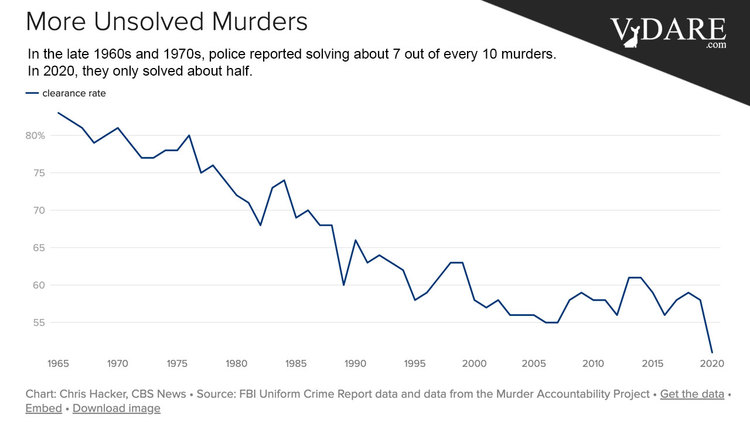
By Steve Sailer
07/08/2022

I doubt if American police forces in 1965 were staffed by Hercule Poirot, Miss Marple, Columbo, and Nancy Drew. But the graph is probably fairly accurate for the last few decades, with the rise of crack gangs in the second half of the 1980s building an infrastructure for witness intimidation. And the sharp decline in 2020 seems characteristic of that lovely year.
From CBS News:
A “coin flip”: Nearly half of U.S. murders go unsolved as cases rise
BY CHRIS HACKER, MATTHEW MOSK, JIM AXELROD, ANDREW BAST, DURRELL DAWSON
UPDATED ON: JUNE 29, 2022 / 10:25 AM / CBS NEWS
… Across a nation that is already in the grips of a rise in violent crime, murders are going unsolved at a historic pace, a CBS News investigation has found. A review of FBI statistics shows that the murder clearance rate — the share of cases each year that are solved, meaning police make an arrest or close the case due to other reasons — has fallen to its lowest point in more than half a century.
“It’s a 50-50 coin flip,” says Thomas Hargrove, who runs the Murder Accountability Project, which tracks unsolved murders nationwide. “It’s never been this bad. During the last seven months of 2020, most murders went unsolved. That’s never happened before in America.”
Let’s see, the last seven months of 2020 were June through December. Did something happen in late May 2020 that made police less effective?
Police are far less likely to solve a murder when the victim is Black or Hispanic, according to CBS News’ analysis. In 2020, the murders of White victims were about 30% more likely to be solved than in cases with Hispanic victims, and about 50% more than when the victims were Black, the data show.
A commenter who is good at arithmetic might wish to estimate what the real black share of murder offenders is if blacks make up 56.5% of known murder offenders in 2020 in cleared cases.
… Police are also contending with a breakdown in trust between their officers and the communities they serve, a result of decades of tensions that spilled over during high-profile cases of police misconduct in recent years. …
In 2020, the Los Angeles Police Department reported a clearance rate of about 55% — slightly better than the national average. But that clearance rate masks a deeper problem: like in many cities, police are less likely to solve the murders of Black victims.
Between 2016 and 2020, the average clearance rate for Black homicide victims in Los Angeles was just 45%, according to CBS News’ analysis of data submitted by the LAPD to the FBI. For White victims, it was 70%.
Jill Leovy reported that about a dozen murder witnesses per year in the early 2000s were in turn murdered in South-Central Los Angeles. Snitches get stitches.
A lot of murders of whites in L.A. are domestics, which are pretty easy to solve: the man of the house did it.
Also, Los Angeles is so expensive that it doesn’t have many traditional white American lowlifes left anymore (except it has a lot of white homeless). Los Angeles has exported to other states many of its white people who might, say, kill somebody in a bar fight with a beer mug to the head. On the other hand, other states have exported a lot of their meth addict white homeless to California. Swings and roundabouts.

In the post-crack era, clearance rates tended to improve (before 2020) for everybody (murder mystery–solving technology is always getting better)…except among blacks, where it continued to get worse. African-Americans have a cultural problem that is conducive to murder and it hasn’t been getting better.
But of course, to say that African-Americans have a murder culture problem is a hateful racist stereotype because it’s true.
In Baltimore, a federal prosecutor hopes to tackle the problem through a partnership headquartered in a nondescript warehouse in a secure location. There, a collaboration of more than 20 local, state and federal agencies work together investigating Baltimore’s most brazen drug syndicates, and a special intelligence unit identifies connections among the city’s hundreds of uncleared murders.
The intelligence unit hopes to follow the “Al Capone strategy” of convicting murder suspects for other crimes being pursued by the interagency partnership.
Former acting U.S. Attorney Jonathan Lenzner started the unit, and in 2021 his office indicted 15 members of a Baltimore gang on charges related to racketeering and drug conspiracy. Prosecutors linked them to unclosed cases involving 18 murders and 27 attempted murders.
That strategy of vacuuming up an entire gang, from kingpin down to foot soldiers, all at once and then convicting them on federal charges so you can send them to random federal prisons thousands of miles away where their girlfriends can’t keep them in the loop on visiting day has had some successes.
This is a content archive of VDARE.com, which Letitia James forced off of the Internet using lawfare.